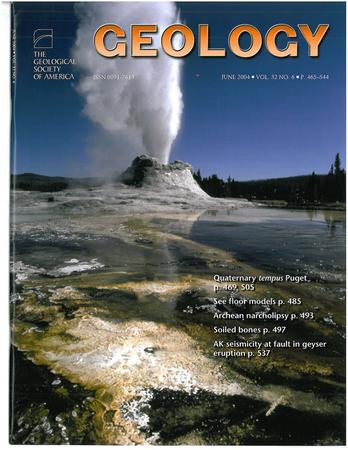Von Damm热液喷口区碳酸盐和镁硅酸盐的千年循环
IF 4.6
1区 地球科学
Q1 GEOLOGY
引用次数: 0
摘要
加勒比海中开曼隆起的冯达姆热泉(VDVF)在现代热液系统中是独一无二的,因为烟囱和土丘几乎完全由滑石组成。我们分析了2020年收集的样品,并报告说,除了可变结晶度的无序滑石外,碳酸盐也是VDVF的主要矿物。碳酸盐矿物包括文石、方解石、富镁方解石和白云石。滑石和碳酸盐矿物结构表明,它们不是代替火山宿主岩石,而是由海底热液和海水的混合沉淀而成,出现在烟囱和周围的碎石中。这种矿物组合的交替沉淀是普遍存在的,碳酸盐矿物通常由滑石接替,并且有迹象表明,在某些情况下,滑石和碳酸盐矿物相互取代。稳定碳同位素数据表明,碳酸盐矿物来源于海水和热液的混合作用,U-Th数据支持了这一观点。放射性碳方解石年龄和滑石234U-230Th等时线年龄表明矿物年龄跨越数千年至数万年。对这些样品的分析说明了一个动态系统,在数千年的时间尺度上,从以碳酸盐为主的降水转变为以镁硅酸盐为主的降水。我们的观察提出了一些问题,关于海底沉淀物的最终命运,以及这些环境中的碳酸盐和硅酸盐矿物是否被隔离并代表在岩石记录中。本文章由计算机程序翻译,如有差异,请以英文原文为准。
Kiloyear cycles of carbonate and Mg-silicate replacement at Von Damm hydrothermal vent field
The Von Damm vent field (VDVF) on the Mid-Cayman Rise in the Caribbean Sea is unique among modern hydrothermal systems in that the chimneys and mounds are almost entirely composed of talc. We analyzed samples collected in 2020 and report that in addition to disordered talc of variable crystallinity, carbonates are a major class of mineral at VDVF. The carbonate minerals include aragonite, calcite, magnesium-rich calcite, and dolomite. Talc and carbonate mineral textures indicate that, rather than replacing volcanic host rock, they precipitate from the mixing of hydrothermal fluids and seawater at the seafloor, occurring in chimneys and surrounding rubble. Alternating precipitation of this mineral assemblage is pervasive, with carbonate minerals typically being succeeded by talc, and with indications that in some cases talc and carbonate minerals replace one another. Stable carbon isotopic data indicate the carbonate minerals originate from the mixing of seawater and hydrothermal fluid, which is supported by U-Th data. Radiocarbon calcite ages and talc 234U-230Th isochron ages indicate mineral ages spanning over thousands to tens of thousands of years. Analyses of these samples illustrate a dynamic system that transitions from carbonate-dominated to Mg-silicate−dominated precipitation over time scales of thousands of years. Our observations raise questions regarding the eventual fate of seafloor precipitates and whether carbonate and silicate minerals in such settings are sequestered and represented in the rock record.
求助全文
通过发布文献求助,成功后即可免费获取论文全文。
去求助
来源期刊

Geology
地学-地质学
CiteScore
10.00
自引率
3.40%
发文量
228
审稿时长
6.2 months
期刊介绍:
Published since 1973, Geology features rapid publication of about 23 refereed short (four-page) papers each month. Articles cover all earth-science disciplines and include new investigations and provocative topics. Professional geologists and university-level students in the earth sciences use this widely read journal to keep up with scientific research trends. The online forum section facilitates author-reader dialog. Includes color and occasional large-format illustrations on oversized loose inserts.
 求助内容:
求助内容: 应助结果提醒方式:
应助结果提醒方式:


